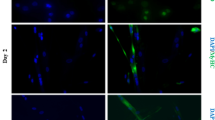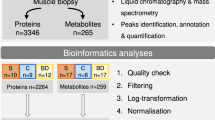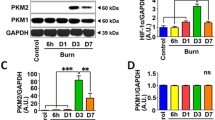Abstract
After severe burn injury, proinflammatory cytokine levels are elevated in serum and skeletal muscle, which in turn increases protein breakdown and decreases protein synthesis. In this study, C2C12 mouse skeletal muscle cell line myotubes were exposed to proinflammatory cytokines tumor necrosis factor-α (TNF-α) and interferon-γ (IFN-γ) as an in vitro cell-line model of catabolic response to burn injury and then treated with des-acyl ghrelin (DAG), a 28 amino acid polypeptide hormone thought to inhibit protein breakdown and increase protein synthesis, to assess its therapeutic potential. Nuclear magnetic resonance-based metabonomics was used to monitor metabolic activity of C2C12 myotubes under four treatment conditions: (1) control, (2) TNF-α/IFN-γ (TI), (3) DAG (DA), and (4) TNF-α/IFN-γ followed by DAG (TIDA) to assess the effect of DAG treatment on cellular metabolic response during basal or catabolic conditions. Twelve metabolites showed significant changes in concentrations following treatments in the hydrophilic cell extracts. Lactate (P < 10−4) and citrulline (P < 10−9) increased with TNF-α/IFN-γ treatment, indicating increased protein degradation, and returned to control levels in the TIDA group. Adenosine nucleotide levels had decreased trends in TI myotubes that returned to baseline levels after DAG treatment (P < 10−4). Guanidinoacetate and pantothenate, metabolites involved in protein synthesis and cell proliferation, had increased concentration trends following DAG treatment in both the DA and TIDA groups. Our metabonomics analysis provides further evidence that DAG counteracts the catabolic response caused by elevated muscle TNF-α/IFN-γ cytokine levels following severe burns and can play a potential therapeutic role in treatment of burn injury.








Similar content being viewed by others
Abbreviations
- NMR:
-
Nuclear magnetic resonance
- PCA:
-
Principal component analysis
- DAG:
-
Des-acyl ghrelin
- TNF-α:
-
Tumor necrosis factor-α
- IFN-γ:
-
Interferon-γ
- TI:
-
TNF-α/IFN-γ treated group
- DA:
-
DAG treated group
- TIDA:
-
TNF-α/IFN-γ followed by DAG treated group
- TI/TIDA:
-
Comparison between TI and TIDA group
- EDL:
-
Extensor digitorum longus
- IGF-I:
-
Insulin-like growth factor-I
References
Alamdari N, Constantin-Teodosiu D, Murton AJ, Gardiner SM, Bennett T, Layfield R et al (2008) Temporal changes in the involvement of pyruvate dehydrogenase complex in muscle lactate accumulation during lipopolysaccharide infusion in rats. J Physiol 586:1767–1775
Alloatti G, Penna C, Mariano F, Camussi G (2000) Role of NO and PAF in the impairment of skeletal muscle contractility induced by TNF-alpha. Am J Physiol Regul Integr Comp Physiol 279:R2156–R2163
Askanazi J, Furst P, Michelsen CB, Elwyn DH, Vinnars E, Gump FE et al (1980) Muscle and plasma amino acids after injury: hypocaloric glucose vs. amino acid infusion. Ann Surg 191:465–472
Balasubramaniam A, Wood S, Joshi R, Su C, Friend LA, Sheriff S et al (2006) Ghrelin stimulates food intake and growth hormone release in rats with thermal injury: synthesis of ghrelin. Peptides 27:1624–1631
Balasubramaniam A, Joshi R, Su C, Friend LA, Sheriff S, Kagan RJ et al (2009) Ghrelin inhibits skeletal muscle protein breakdown in rats with thermal injury through normalizing elevated expression of E3 ubiquitin ligases MuRF1 and MAFbx. Am J Physiol Regul Integr Comp Physiol 296:R893–R901
Baldanzi G, Filigheddu N, Cutrupi S, Catapano F, Bonissoni S, Fubini A et al (2002) Ghrelin and des-acyl ghrelin inhibit cell death in cardiomyocytes and endothelial cells through ERK1/2 and PI 3-kinase/AKT. J Cell Biol 159:1029–1037
Bessman SP, Carpenter CL (1985) The creatine–creatine phosphate energy shuttle. Annu Rev Biochem 54:831–862
Blomqvist BI, Hammarqvist F, von der Decken A, Wernerman J (1995) Glutamine and α-ketoglutarate prevent the decrease in muscle free glutamine concentration and influence protein synthesis after total hip replacement. Metab Clin Exp 44:1215–1222
Brancaccio P, Lippi G, Maffulli N (2010) Biochemical markers of muscular damage. Clin Chem Lab Med 48:757–767
Buchman AL (2009) The addition of choline to parenteral nutrition. Gastroenterology 137:S119–S128
Bundy JG, Papp B, Harmston R, Browne RA, Clayson EM, Burton N et al (2007) Evaluation of predicted network modules in yeast metabolism using NMR-based metabolite profiling. Genome Res 17:510–519
Cassoni P, Ghe C, Marrocco T, Tarabra E, Allia E, Catapano F et al (2004) Expression of ghrelin and biological activity of specific receptors for ghrelin and des-acyl ghrelin in human prostate neoplasms and related cell lines. Eur J Endocrinol 150:173–184
Cioffi WG, Gore DC, Rue LW 3rd, Carrougher G, Guler HP, McManus WF et al (1994) Insulin-like growth factor-1 lowers protein oxidation in patients with thermal injury. Ann Surg 220:310–316 discussion 316–319
Crossland H, Constantin-Teodosiu D, Gardiner SM, Constantin D, Greenhaff PL (2008) A potential role for Akt/FOXO signalling in both protein loss and the impairment of muscle carbohydrate oxidation during sepsis in rodent skeletal muscle. J Physiol 586:5589–5600
Crossland H, Constantin-Teodosiu D, Greenhaff PL, Gardiner SM (2010) Low-dose dexamethasone prevents endotoxaemia-induced muscle protein loss and impairment of carbohydrate oxidation in rat skeletal muscle. J Physiol 588:1333–1347
da Costa KA, Badea M, Fischer LM, Zeisel SH (2004) Elevated serum creatine phosphokinase in choline-deficient humans: mechanistic studies in C2C12 mouse myoblasts. Am J Clin Nutr 80:163–170
Dehoux M, Van Beneden R, Pasko N, Lause P, Verniers J, Underwood L et al (2004) Role of the insulin-like growth factor I decline in the induction of atrogin-1/MAFbx during fasting and diabetes. Endocrinology 145:4806–4812
Duarte IF, Marques J, Ladeirinha AF, Rocha C, Lamego I, Calheiros R et al (2009) Analytical approaches toward successful human cell metabolome studies by NMR spectroscopy. Anal Chem 81:5023–5032
Endo S, Inada K, Yamada Y, Kasai T, Takakuwa T, Nakae H et al (1993) Plasma tumour necrosis factor-alpha (TNF-alpha) levels in patients with burns. Burns 19:124–127
Ferretti A, D’Ascenzo S, Knijn A, Iorio E, Dolo V, Pavan A et al (2002) Detection of polyol accumulation in a new ovarian carcinoma cell line, CABA I: a(1)H NMR study. Br J Cancer 86:1180–1187
Filigheddu N, Gnocchi VF, Coscia M, Cappelli M, Porporato PE, Taulli R et al (2007) Ghrelin and des-acyl ghrelin promote differentiation and fusion of C2C12 skeletal muscle cells. Mol Biol Cell 18:986–994
Finnerty CC, Jeschke MG, Herndon DN, Gamelli R, Gibran N, Klein M et al (2008) Temporal cytokine profiles in severely burned patients: a comparison of adults and children. Mol Med 14:553–560
Finnerty CC, Przkora R, Herndon DN, Jeschke MG (2009) Cytokine expression profile over time in burned mice. Cytokine 45:20–25
Forgue P, Halouska S, Werth M, Xu K, Harris S, Powers R (2006) NMR metabolic profiling of Aspergillus nidulans to monitor drug and protein activity. J Proteome Res 5:1916–1923
Galons JP, Fantini J, Vion-Dury J, Cozzone PJ, Canioni P (1989) Metabolic changes in undifferentiated and differentiated human colon adenocarcinoma cells studied by multinuclear magnetic resonance spectroscopy. Biochimie 71:949–961
Gladden LB (2004) Lactate metabolism: a new paradigm for the third millennium. J Physiol 558:5–30
Gnanapavan S, Kola B, Bustin SA, Morris DG, McGee P, Fairclough P et al (2002) The tissue distribution of the mRNA of ghrelin and subtypes of its receptor, GHS-R, in humans. J Clin Endocrinol Metab 87:2988
Goodpaster AM, Romick-Rosendale LE, Kennedy MA (2010) Statistical significance analysis of nuclear magnetic resonance-based metabonomics data. Anal Biochem 401:134–143
Gottschalk M, Ivanova G, Collins DM, Eustace A, O’Connor R, Brougham DF (2008) Metabolomic studies of human lung carcinoma cell lines using in vitro (1)H NMR of whole cells and cellular extracts. NMR Biomed 21:809–819
Hart DW, Wolf SE, Mlcak R, Chinkes DL, Ramzy PI, Obeng MK et al (2000) Persistence of muscle catabolism after severe burn. Surgery 128:312–319
Hedden MP, Buse MG (1982) Effects of glucose, pyruvate, lactate, and amino acids on muscle protein synthesis. Am J Physiol 242:E184–E192
Herndon DN, Ramzy PI, DebRoy MA, Zheng M, Ferrando AA, Chinkes DL et al (1999) Muscle protein catabolism after severe burn: effects of IGF-1/IGFBP-3 treatment. Ann Surg 229:713–720 discussion 720–722
Hosoda H, Kojima M, Mizushima T, Shimizu S, Kangawa K (2003) Structural divergence of human ghrelin. Identification of multiple ghrelin-derived molecules produced by post-translational processing. J Biol Chem 278:64–70
Ingwall JS, Wildenthal K (1976) Role of creatine in the regulation of cardiac protein synthesis. J Cell Biol 68:159–163
Inhoff T, Mönnikes H, Noetzel S, Stengel A, Goebel M, Dinh QT et al (2008) Desacyl ghrelin inhibits the orexigenic effect of peripherally injected ghrelin in rats. Peptides 29:2159–2168
Jones SB, Romano FD (1989) Dose- and time-dependent changes in plasma catecholamines in response to endotoxin in conscious rats. Circ Shock 28:59–68
Koga T, Zhang WY, Gotoh T, Oyadomari S, Tanihara H, Mori M (2003) Induction of citrulline-nitric oxide (NO) cycle enzymes and NO production in immunostimulated rat RPE-J cells. Exp Eye Res 76:15–21
Kojima M, Hosoda H, Date Y, Nakazato M, Matsuo H, Kangawa K (1999) Ghrelin is a growth-hormone-releasing acylated peptide from stomach. Nature 402:656–660
Kola B, Hubina E, Tucci SA, Kirkham TC, Garcia EA, Mitchell SE et al (2005) Cannabinoids and ghrelin have both central and peripheral metabolic and cardiac effects via AMP-activated protein kinase. J Biol Chem 280:25196–25201
Korbonits M, Goldstone AP, Gueorguiev M, Grossman AB (2004) Ghrelin—a hormone with multiple functions. Front Neuroendocrinol 25:27–68
Lee IJ, Hom K, Bai G, Shapiro M (2009) NMR metabolomic analysis of caco-2 cell differentiation. J Proteome Res 8:4104–4108
Li WG, Gavrila D, Liu X, Wang L, Gunnlaugsson S, Stoll LL et al (2004) Ghrelin inhibits proinflammatory responses and nuclear factor-{kappa}B activation in human endothelial cells. Circulation 109:2221–2226
Mori M, Gotoh T (2004) Arginine metabolic enzymes, nitric oxide and infection. J Nutr 134:2820S–2825S discussion 2853S
Osowska S, Duchemann T, Walrand S, Paillard A, Boirie Y, Cynober L et al (2006) Citrulline modulates muscle protein metabolism in old malnourished rats. Am J Physiol Endocrinol Metab 291:E582–E586
Padfield KE, Astrakas LG, Zhang Q, Gopalan S, Dai G, Mindrinos MN et al (2005) Burn injury causes mitochondrial dysfunction in skeletal muscle. Proc Natl Acad Sci USA 102:5368–5373
Pereira C, Murphy K, Jeschke M, Herndon DN (2005) Post burn muscle wasting and the effects of treatments. Int J Biochem Cell Biol 37:1948–1961
Romick-Rosendale LE, Goodpaster AM, Hanwright PJ, Patel NB, Wheeler ET, Chona DL et al (2009) NMR-based metabonomics analysis of mouse urine and fecal extracts following oral treatment with the broad-spectrum antibiotic enrofloxacin (Baytril). Magn Reson Chem 47:S36–S46
Shea JE, Bowman BM, Miller SC (2003) Alterations in skeletal and mineral metabolism following thermal injuries. J Musculoskelet Neuronal Interact 3:214–222
Tessem MB, Swanson MG, Keshari KR, Albers MJ, Joun D, Tabatabai ZL et al (2008) Evaluation of lactate and alanine as metabolic biomarkers of prostate cancer using 1H HR-MAS spectroscopy of biopsy tissues. Magn Reson Med 60:510–516
Triba MN, Starzec A, Bouchemal N, Guenin E, Perret GY, Le Moyec L (2010) Metabolomic profiling with NMR discriminates between biphosphonate and doxorubicin effects on B16 melanoma cells. NMR Biomed 23(9):1009–1016
Vary TC, Hazen SA, Maish G, Cooney RN (1998) TNF binding protein prevents hyperlactatemia and inactivation of PDH complex in skeletal muscle during sepsis. J Surg Res 80:44–51
Waters NJ, Holmes E, Waterfield CJ, Farrant RD, Nicholson JK (2002) NMR and pattern recognition studies on liver extracts and intact livers from rats treated with α-naphthylisothiocyanate. Biochem Pharmacol 64:67–77
Weimann BI, Hermann D (1999) Studies on wound healing: effects of calcium D-pantothenate on the migration, proliferation and protein synthesis of human dermal fibroblasts in culture. Int J Vitam Nutr Res 69:113–119
Williams G, Brown T, Becker L, Prager M, Giroir BP (1994) Cytokine-induced expression of nitric oxide synthase in C2C12 skeletal muscle myocytes. Am J Physiol 267:R1020–R1025
Acknowledgments
The authors would like to acknowledge support of Miami University and the Ohio Board of Regents for funding to establish the Ohio Eminent Scholar Laboratory where the work was performed. This study is supported in part by Shriners Hospital for Children grant # 864006 (AB) and a Department of Veteran Affairs Grant #1I01BX000263 (AB). The authors would also like to acknowledge support from Bruker Biospin, Inc that enabled development of the statistical significance analysis software used in the analysis of the data reported in this paper. MW would like to acknowledge support of a Miami University Cell, Molecular, and Structural Biology Fellowship.
Author information
Authors and Affiliations
Corresponding author
Additional information
Miki Watanabe and Sulaiman Sheriff contributed equally to this work.
Electronic supplementary material
Below is the link to the electronic supplementary material.
Rights and permissions
About this article
Cite this article
Watanabe, M., Sheriff, S., Ramelot, T.A. et al. NMR Based Metabonomics Study of DAG Treatment in a C2C12 Mouse Skeletal Muscle Cell Line Myotube Model of Burn-Injury. Int J Pept Res Ther 17, 281 (2011). https://doi.org/10.1007/s10989-011-9264-x
Accepted:
Published:
DOI: https://doi.org/10.1007/s10989-011-9264-x




